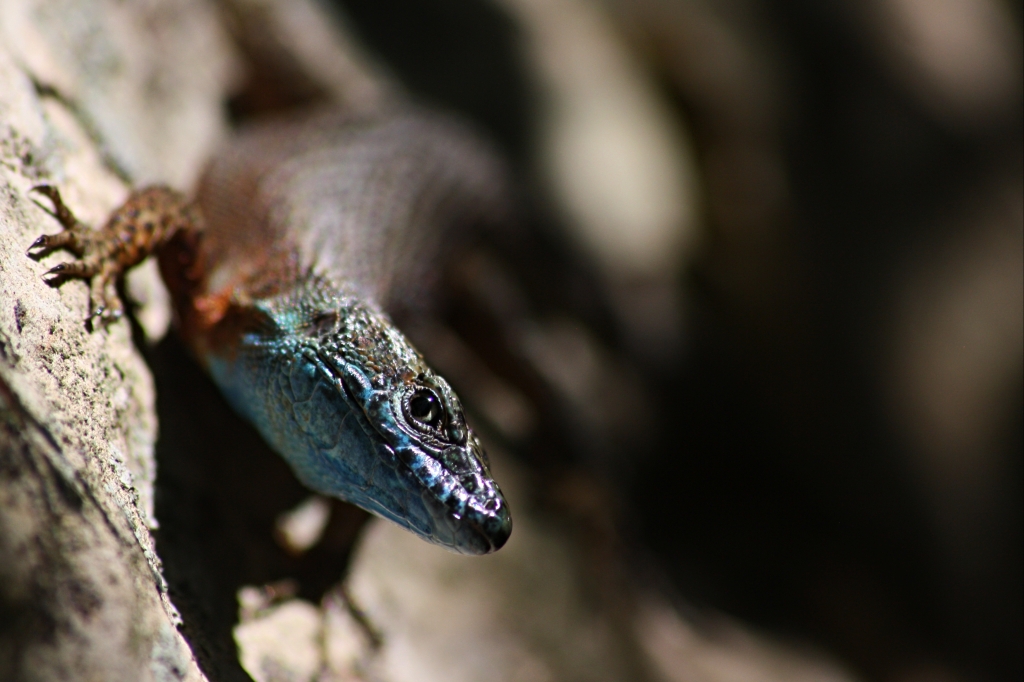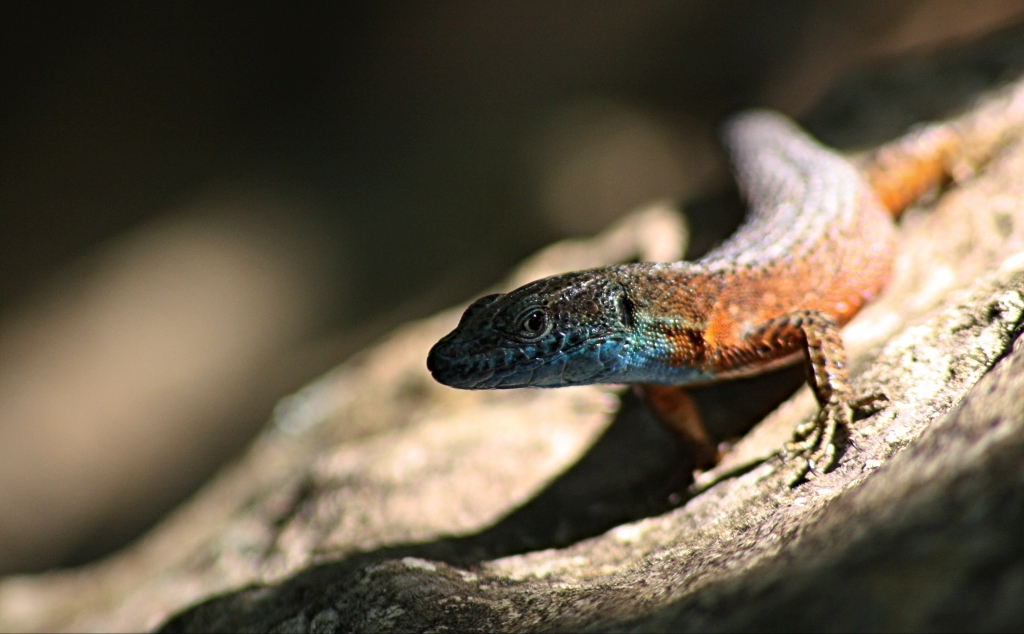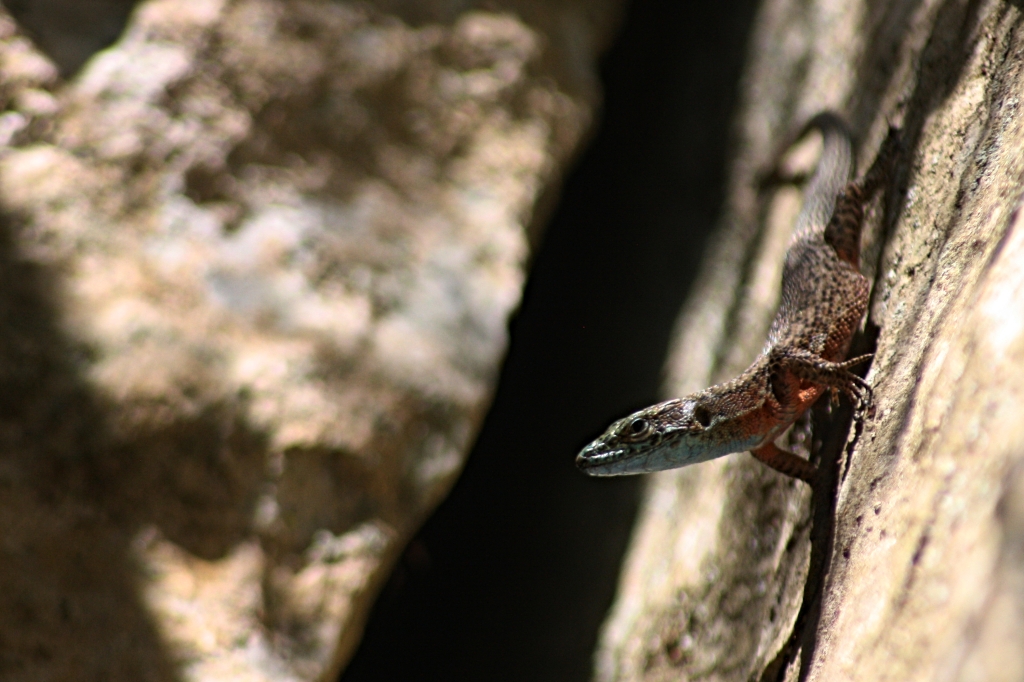These handsome little lizards proved to be quite tricksome to find, owing to their fairly specific habitat requirements. Once we’d actually found a couple of the elusive areas that ticked all of the microhabitat boxes, they were pretty abundant. The species is notoriously skittish (apparently even more so when you have a camera), so the final step was earning their trust, mastering their various habits and cultural values – embedding myself in their society. All this with the humble aim of getting pictures for an incredibly niche blog that’s so far south of useful it makes a glass hammer look practical…

The genus Algyroides is comprised of four species, characterised by a distinct overlapping, keeled scalation on the back giving them an armoured appearance. All four species prefer shaded and humid habitats (relatively rare in the Mediterranean) which is a main driving factor behind the disjointed ranges of each of the species across southern Europe. Algyroides nigropunctatus is the most widely distributed species within the genus, ranging along the Adriatic coast from NE Italy right down to Greece, including many of the islands along the coastline.
Rocky outcrops alongside rivers in open or semi-open woodland are the perfect habitat for these lizards. In the right habitat they can be found in abundance scooting around between basking sites in dappled sunlight. They eat a range of invertebrate prey, such as spiders and grasshoppers. Females can lay up to two clutches of between two and eight eggs which normally happens in May. They are listed as “Least Concern” by the IUCN.

Colouration-wise they are clearly nothing like the Dalmatians of the canine variety. The female lizards have a whitish-yellow ventral colouration, sometimes spicing it up with a small amount of blue on the throat. It’s only the males that have the bright blue throat and red belly colour combo, which becomes almost fluorescent in the breeding season. Anyone familiar with the colour wheel may also have noticed that the orange-blue juxtaposition is particulalry striking as they are complementary colours. The blue section of the body is reflecting in the region of the visible spectrum (for humans at least) where the orange part isn’t and vice versa. This suggests that this colour configuration has been selected for through evolution to absolutely maximise the signal’s conspicuousness to receivers. It’s fashion 101, and these lizards have got it.

So attractive is this colouration, it made one group of researchers want to find out more about the exact spectra of these colours. Badiane et al. (2018) took UV photos of a few dozen A. nigropunctatus alongside the same photos in the human visible spectra. They found that the blue colouration of these lizards has a spectral peak in the blue wavelengths as well as a strong plateau in the UV wavelength range in all the bodily areas where blue is present; the throat, upper chest and supralabial scales (upper lip). Some individuals also had some spots on their flanks that were highly UV reflective too.

So what does this mean? Firstly, of course, it means that obviously these lizards would look totally hypnotic at a rave. However, what is arguably more important is that these lizards are likely using these visual and UV signals in conjunction to convey information to each other. This could be between males, advertising their strength or physical fitness to potential rivals or for male-female interactions where the brilliance of the colouration could be displaying to potential mates whether or not an individual would provide good genes for healthy, successful offspring. Algyroides, like many lizard species, are able to see in the UV range, so this colouration is likely encoding far more information than it would appear to us and our pitiful three-coned visual system.

Sadly there is basically nothing known about the behaviour and interactions of these colourful little lacertids. As a result, much of the true function of these signals is currently just guesswork! If I continue screaming for science to take basic natural history studies seriously maybe one day it will happen? Probably not but I’ll never stop…
Quick facts:
- Endemic to the eastern Adriatic and Ionian coastline; NE Italy, Slovenia, Croatia, Bosnia and Herzegovina, Montenegro, Albania, Macedonia, Serbia and Greece.
- Blue areas of the colouration reflect strongly in the UV wavelengths of light.
- Desperate need for more basic research on the species!
References:
Speybroeck, J., Beukema, W., Bok, B. & Van Der Voort, J. (2016). Field Guide to the Amphibians and Reptiles of Britain and Europe. London, Bloomsbury Publishing.
Badiane, A., Carazo, P., & Font, E. (2018). Colouration in male blue-throated keeled lizards (Algyroides nigropunctatus): Evidence for ultraviolet reflectance of throat and lateral patches. Herpetological Journal, 28(1).